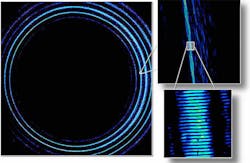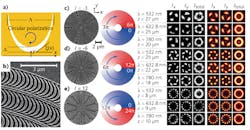Light with extremely high orbital angular momentum has exquisitely fine structure
If light is given a twisted phase via a suitable optical element, it acquires orbital angular momentum (OAM). The higher the OAM of a photon, the more information it can carry; as a result, OAM is a hot topic now in leading-edge optical communications and quantum optics experiments. For example, data rates of up to 100 terabits per second have already been achieved under laboratory conditions. Optics that produce OAM include refractive, holographic or other refractive, reflective, or spatial light modulators (SLMs). The OAM quantum number in a beam can be quantified by the number of 2π phase discontinuities in the optics; for example, the OAM numbers in the beam profiles below range from 3 to 12.
Now, researchers from the University of Vienna (Vienna, Austria) and Australian National University (Canberra, Australia) have created beams with OAM quantum numbers of more than 10,000, resulting in strange multiringed beam profiles with exquisite detail in the rings (as one can see in the multiple zoom-ins in the figure at the very top).1 This structure is inherent in the individual photons in the beam.The researchers wanted to determine whether quantum physics still held in the limit of large quantum numbers, or whether classical physics and everyday experience took over. For this purpose, the researchers took advantage of a technique developed by the colleagues in Australia. There, they fabricated spiral phase mirrors to twist photons in an unprecedentedly strong manner, thus increasing the quantum numbers to huge values. The mirrors, custom-made for the experiment in Vienna, allow the generation of OAM photons with huge quantum numbers a hundred times larger than in previous experiments.
The Viennese researchers generated entangled photon pairs, then twisted one of the photons with the Australian mirrors without destroying the entanglement, thus demonstrating that quantum physics even holds if five-digit quantum numbers are entangled. Although driven by foundational questions, future applications can already be anticipated.
"The enormous complexity of the light's structure is fascinating and can be seen as an intuitive indication about how much information should fit on a single photon," says Robert Fickler, lead author of the study.
Source: http://vcq.quantum.at/news/news/detail/562.html
REFERENCE:
1. R. Fickler et al., arXiv:1607.00922v1 [quant-ph] (2016); https://arxiv.org/abs/1607.00922
About the Author
John Wallace
Senior Technical Editor (1998-2022)
John Wallace was with Laser Focus World for nearly 25 years, retiring in late June 2022. He obtained a bachelor's degree in mechanical engineering and physics at Rutgers University and a master's in optical engineering at the University of Rochester. Before becoming an editor, John worked as an engineer at RCA, Exxon, Eastman Kodak, and GCA Corporation.


